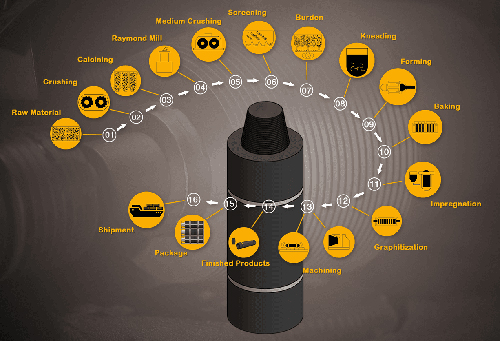How graphite electrodes are manufactured?
Graphite electrodes are a critical component in various high-temperature industrial processes, particularly in steel production and electric arc furnaces. Their role in conducting electrical current and withstanding extreme temperatures is vital. What graphite electrodes are and why they are indispensable?
Composition: Graphite electrodes are primarily composed of high-purity graphite, often derived from petroleum coke.
Function: These electrodes serve as conductors of electrical current, transferring it to the electric arc furnace, where it facilitates the transformation of raw materials into molten metal.
The creation of graphite electrodes is a meticulously controlled process, ensuring the highest quality and performance. Here is a step-by-step breakdown:
1. Raw Material Selection
Begins with the selection of the finest raw materials, primarily petroleum coke. This raw material undergoes a series of treatments, including calcination and baking, to produce needle coke. Needle coke forms the basis of high-quality graphite electrodes due to its exceptional conductivity and low thermal expansion properties.
2. Milling and Shaping
The shaped electrodes are subjected to high-temperature baking in specialized furnaces, where they are exposed to temperatures exceeding 3,000 degrees Celsius. This intense heat treatment serves multiple purposes:
It removes impurities from the graphite, enhancing its purity.
It strengthens the structure, ensuring the electrodes can withstand extreme conditions.
It sets the final dimensions and properties of the electrodes.
4. Impregnation (Optional)
In some cases, electrodes may undergo an impregnation process, wherein they are filled with a pitch-based material. This additional step further improves their mechanical strength and electrical conductivity, making them more resilient in demanding applications.
5. Machining and Quality Control
After baking, electrodes are subjected to precision machining to meet exacting dimensions and specifications. Rigorous quality control measures are applied to identify and rectify any imperfections. Only electrodes meeting stringent quality standards proceed to the next stage.
6. Nipple Installation
Many graphite electrodes are equipped with nipples at one end, allowing for easy connection to the power source. These nipples are carefully integrated into the electrode structure, ensuring a secure and efficient electrical connection.
7. Final Inspection and Packaging
Before leaving the manufacturing facility, each electrode undergoes a final inspection to verify its quality and adherence to specifications. Any remaining imperfections are addressed, and the electrodes are packaged for shipment to customers.
Prev: Who is the Largest Producer of Graphite Electrodes?
Next: Why Choose a Reputable Manufacturer?
Composition: Graphite electrodes are primarily composed of high-purity graphite, often derived from petroleum coke.
Function: These electrodes serve as conductors of electrical current, transferring it to the electric arc furnace, where it facilitates the transformation of raw materials into molten metal.
The creation of graphite electrodes is a meticulously controlled process, ensuring the highest quality and performance. Here is a step-by-step breakdown:
1. Raw Material Selection
Begins with the selection of the finest raw materials, primarily petroleum coke. This raw material undergoes a series of treatments, including calcination and baking, to produce needle coke. Needle coke forms the basis of high-quality graphite electrodes due to its exceptional conductivity and low thermal expansion properties.
2. Milling and Shaping
The needle coke is milled into a fine powder, which is then mixed with a binder material. This mixture is extruded into the desired electrode shape. The precision in shaping is crucial to ensure the electrode's efficiency and durability in demanding industrial settings.

The shaped electrodes are subjected to high-temperature baking in specialized furnaces, where they are exposed to temperatures exceeding 3,000 degrees Celsius. This intense heat treatment serves multiple purposes:
It removes impurities from the graphite, enhancing its purity.
It strengthens the structure, ensuring the electrodes can withstand extreme conditions.
It sets the final dimensions and properties of the electrodes.
4. Impregnation (Optional)
In some cases, electrodes may undergo an impregnation process, wherein they are filled with a pitch-based material. This additional step further improves their mechanical strength and electrical conductivity, making them more resilient in demanding applications.
5. Machining and Quality Control
After baking, electrodes are subjected to precision machining to meet exacting dimensions and specifications. Rigorous quality control measures are applied to identify and rectify any imperfections. Only electrodes meeting stringent quality standards proceed to the next stage.
6. Nipple Installation
Many graphite electrodes are equipped with nipples at one end, allowing for easy connection to the power source. These nipples are carefully integrated into the electrode structure, ensuring a secure and efficient electrical connection.
7. Final Inspection and Packaging
Before leaving the manufacturing facility, each electrode undergoes a final inspection to verify its quality and adherence to specifications. Any remaining imperfections are addressed, and the electrodes are packaged for shipment to customers.





